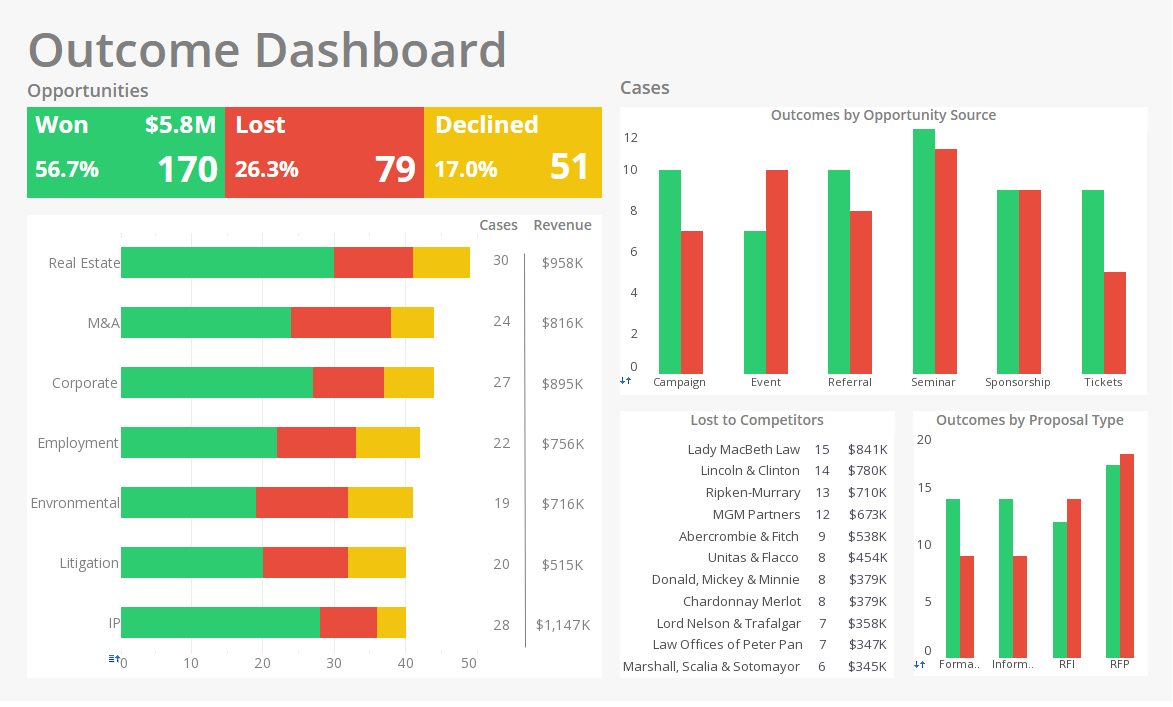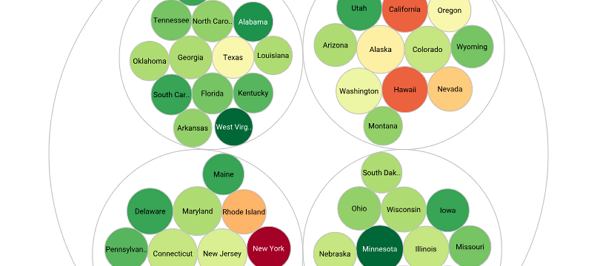Reviewing Law Firm KPIs
This is the continuation of the transcript on the topic of "Applying Analytics to Improve Performance in Law Firms." The moderator is Mark Flaherty.
So we set off in to set up a workshop with four or five senior partners and the managing partner and the deputy managing partner. We reviewed all the alternative structures that were available a law firm like us, and we also reviewed all our different financial reports and all our different KPIs.
We workshopped them for probably two or three months. Most of that was because of structural issues of who could work with whom and what would work best. What we came down to was a group of 24, we call them, clusters. Each cluster is between six to 10 partners and the supporting lawyers and support staff, and we pointed cluster leaders to look after them, and we created five business line leaders for them to report to.
So that was the new management structure. And the second thing is that we went through all our KPIs, and we had probably 30 KPIs that we would report on regularly, and we got that down to a list of 10 KPIs that we thought would drive the performance of the firm and particularly improve the profitability of the firm.
Mark: What was your thinking that drove you to want to cut down on the number of KPIs, Greg?
Ron: The main thing was, Mark, that we thought that was just too many, and that it was too much clutter, and I guess noise. And also, in our environment, typically, with lawyers, they would like more evidence or more proofs. So over the years, we built out just dozens of KPIs and then more and more detail to support that. So it got to be lots of reports, but we are trying to get it down to something simple and clear that they could have that we could measure and report, and they knew they would be accountable for it.
Mark: I would say that we have seen that here across a number of firms, as well. It does make sense to keep the number of KPIs down to a reasonable number. Ten is probably about as many as you would want to think for any given group. Different groups might have different KPIs, but certainly, the idea of not having too many resonates with what we have seen, as well.
Ron: Yes, that’s our plan, and certainly we haven’t taken out any other reports. We still have the other reports. So particular people might need a particular report. I can still see that, and certainly some people need that sort of transactional details. So it is still available to lawyers or the partners to go and look at. Now we have got the high level few KPIs reported on in our dashboards, and that’s driving the business. And we have still got the supporting reports that they can get right into the detail if that’s what they think they need to manage it.
Mark: So this was around July that you agreed on the smaller number of key performance indicators and had the cluster structure in place. What happened then?
Ron: Well, the good part of the story was that as we were developing the KPIs and getting down to the structure, which was roundabout May, our financial year ends in June, and that was the deadline to get the new structure and new KPIs in place for 1 July, the new financial year. In May, we just became aware that InetSoft was launching the tablet version of the InetSoft BI solution.
So I spoke to the InetSoft guys saying, can you help us with a prototype. We had built a bit of a mockup of what we would like to do and how to show the KPIs and the dashboard, and the InetSoft guys took that away for a couple of days, and they built up a proof of concept for us.
So what happened was we got to June, and we had a two-day workshop with about 30 of our partners. So it was a fairly high investment by our firm. We have got guys charging $1,000 an hour, and we had 30 of them in a room not supervising other lawyers, so it was a big investment to get them all there. And we launched the charts, the KPIs; we told them about the structure.
These were the guys that were going to be involved in that structure, and we would put them in to manage their different teams which we called clusters. And that was a two-day workshop. At the end of that, and I hadn’t told anyone that we had it, I was able to plug in an iPad and put it up on the projector, and none of them had seen it before.
What Are the 5 KPIs Law Firms Are Not Tracking But Need to?
Law firms operate in a competitive and highly regulated environment where success depends not just on legal expertise but on operational efficiency, client satisfaction, and financial performance. While many firms track standard metrics such as billable hours, revenue per partner, and client acquisition, there are key performance indicators (KPIs) that are often overlooked yet critical for long-term growth and risk management. Identifying and tracking these underutilized KPIs can provide law firms with insights to optimize workflows, improve client service, and make better strategic decisions.
1. Client Retention Rate
Many law firms focus heavily on acquiring new clients but neglect the importance of retaining existing ones. Client retention rate measures the percentage of clients who continue to engage the firm’s services over a specified period. A declining retention rate can indicate dissatisfaction, pricing issues, or ineffective communication. By tracking this KPI, firms can identify at-risk clients and implement strategies such as follow-ups, personalized engagement, or service improvement initiatives. Improving client retention often costs less than acquiring new clients and directly impacts long-term revenue stability.
Tracking client retention also allows firms to correlate retention with service types or practice areas, helping allocate resources efficiently. For example, if corporate clients are consistently retained while litigation clients drop off, the firm can investigate differences in service delivery or client expectations and adjust its approach.
2. Matter Profitability by Case Type
While overall profitability is commonly monitored, law firms often fail to analyze profitability at the matter or case type level. Matter profitability measures revenue generated minus the direct costs, including attorney time, paralegal work, court fees, and other expenses. Without this granularity, firms may unknowingly continue working on low-margin cases that consume disproportionate resources.
Tracking matter profitability allows firms to make informed decisions about which cases to pursue, adjust billing structures, and allocate staffing effectively. For instance, if certain case types consistently show low or negative profitability, the firm can refine pricing strategies, outsource routine tasks, or limit those engagements. This KPI directly impacts the firm’s financial sustainability and strategic planning.
3. Employee Utilization vs. Capacity
Law firm productivity is often measured by billable hours alone, but this metric does not capture whether staff are being utilized efficiently relative to their full capacity. Employee utilization versus capacity tracks how much work lawyers and support staff are completing compared to the hours available. High utilization rates may indicate overwork and potential burnout, while low rates suggest underutilization of talent.
By monitoring this KPI, law firms can balance workloads, improve employee satisfaction, and identify gaps in staffing. For example, if senior associates are consistently under capacity while paralegals are overloaded, redistributing tasks or providing additional training can optimize resource use. Efficient utilization also enhances profitability, reduces employee turnover, and ensures timely client service.
4. Client Feedback and Satisfaction Scores
Law firms rarely have systematic measures of client satisfaction beyond informal conversations or anecdotal feedback. Implementing a client satisfaction KPI, such as Net Promoter Score (NPS) or structured surveys, provides measurable insights into how clients perceive the firm’s service, communication, and responsiveness. Poor client satisfaction can lead to attrition, negative reviews, and loss of referral business.
Regularly tracking client feedback helps firms identify areas for improvement, set service benchmarks, and develop targeted strategies to enhance client experience. Over time, trends in satisfaction scores can guide training programs, process improvements, and strategic decisions that directly impact client loyalty and revenue growth.
5. Technology Adoption and Efficiency Gains
In the age of digital transformation, law firms often invest in practice management software, document automation, or AI-driven research tools but rarely track how effectively these technologies are utilized. Measuring technology adoption and efficiency gains as a KPI helps determine whether these investments are delivering tangible value. Metrics may include percentage of cases processed using automation, time saved per task, or reduction in errors and redundancies.
Tracking this KPI allows firms to optimize technology deployment, identify training needs, and quantify ROI on software investments. For example, if document automation reduces drafting time by 30%, the firm can reallocate lawyer hours to higher-value tasks, improving both productivity and profitability. This KPI also encourages a culture of innovation and continuous improvement.




